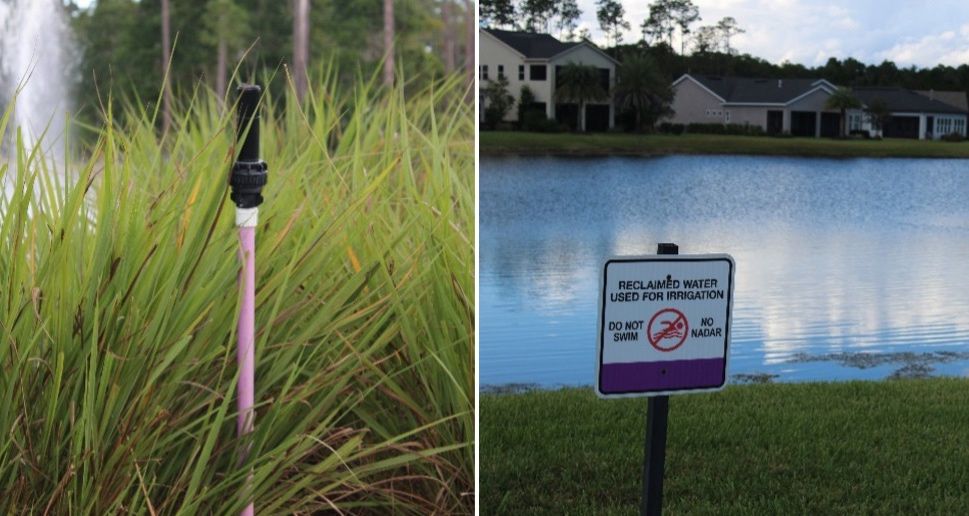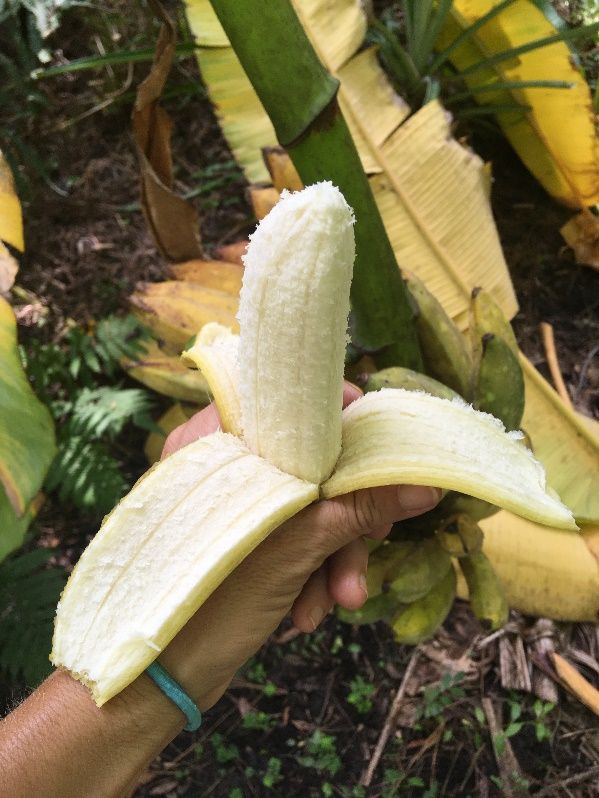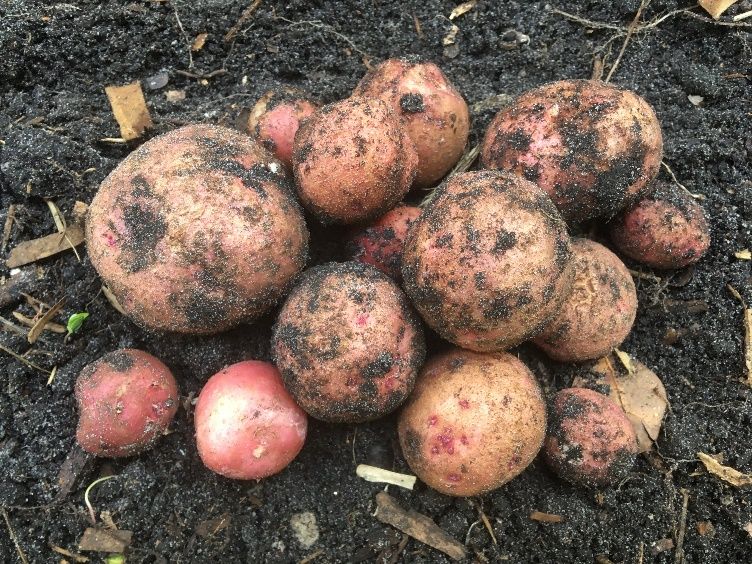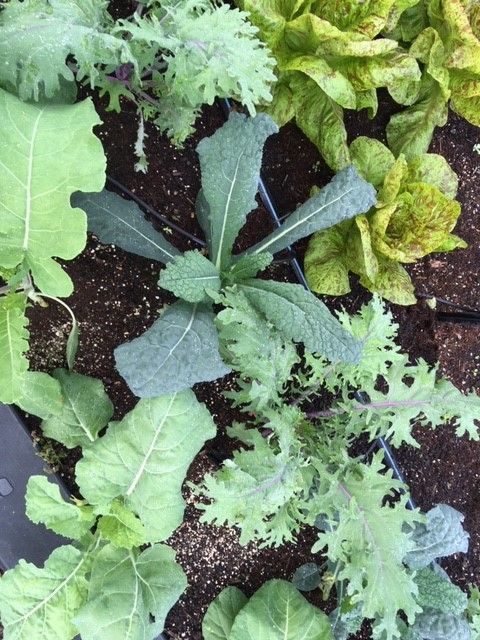Introduction
Reclaimed water plays a significant role in water conservation, a goal of every Florida-Friendly Landscape. Irrigating lawn and landscape plants with reclaimed water conserves potable drinking water while recharging groundwater. Reclaimed water is ideal for irrigating golf courses, commercial car washes, supplying water to wetlands, and certain commercial agricultural crops. However, using reclaimed water on plants harvested and consumed from the home landscape must be approached with caution for vegetables, fruit trees, herbs, and other edible crops due to the risk of contamination from pathogens and salts (Figure 1). Additionally, it is important to understand that reclaimed water contains detectable amounts of nutrients. Before using reclaimed water in your Florida-Friendly edible garden, it is important to have a clear understanding of what it is and how it can be safely used. The target audience for this publication is Florida residents who irrigate landscapes, including edibles, with reclaimed water. To learn more about Florida-Friendly Landscaping with edibles, see Edible Landscaping Using the Nine Florida-Friendly Landscaping™ Principles: https://edis.ifas.ufl.edu/publication/EP594.

Credit: Terra Freeman, UF/IFAS
What is reclaimed water?
Reclaimed water is wastewater that has been treated for reuse in the environment. Once treated, reclaimed water is clean, clear, and usually odorless, but it still contains salts, nutrients, and pathogens. Wastewater is collected from households, hospitals, schools, and other facilities at wastewater treatment facilities, then treated to remove solids and certain impurities before being discharged back into waterways or piped into communities for reuse (Figure 2). Reclaimed water is required to go through a minimum of two treatment processes to remove waste, while many go through three treatments to further disinfect and remove harmful constituents. Reclaimed water must meet water quality standards established by the Florida Department of Environmental Protection. Reclaimed water is safe to use on lawns and many ornamental plants in the landscape; however, it is never to be used for drinking or sanitary purposes. Florida Department of Environmental Protection (FDEP) requires all irrigation components to be tagged or labeled “Do not drink” in English and “No beber” in Spanish to warn the public that the water is not intended for drinking (FDEP 2021). Always wash your hands with potable water after contact with reclaimed water. For more information, see Reclaimed Water Use in the Landscape: Frequently Asked Questions about Reclaimed Water (https://edis.ifas.ufl.edu/publication/ss544) and Reclaimed Water Use in the Landscape: What's in Reclaimed Water and Where Does It Go? (https://edis.ifas.ufl.edu/publication/ss542).

Credit: Terra Freeman, UF/IFAS
Salts, Nutrients and Pathogens in Reclaimed Water
While reclaimed water has been highly treated and disinfected, it may still contain higher levels of nutrients, salts, and pathogens than are considered safe for consumption. Most reclaimed water contains nutrients, such as nitrogen and phosphorus, that can contribute to the landscape’s fertilization needs; therefore, fertilization could potentially be reduced to account for the extra nutrients in reclaimed water. Levels of nutrients vary according to the source, so check with your water provider for specifics. If the average nutrient levels are consistently elevated, the amount of fertilizer applied to the landscape may be reduced.
The level of total dissolved salts available in reclaimed water is problematic for many edible crops. Salts in reclaimed water can result in foliar damage, reduced seed germination and rooting, and reduced water availability to plant roots. Crops possess varying levels of salt tolerance; anything over 1000 parts per million is too high for most. Bell peppers, broccoli, and loquats are highly salt tolerant. Cauliflower, peas, squash and sweet corn are moderately salt tolerant. Beans, celery, and cucumbers have low salt tolerance. For more information on salt tolerance of crops, refer to Soil and Container Media Electrical Conductivity Interpretations (https://edis.ifas.ufl.edu/publication/ss117).
The US Environmental Protection Agency (EPA) (2004) has stringent guidelines to keep biological factors in reclaimed water to a safe minimum. Pathogens found in reclaimed water include microorganisms such as viruses, bacteria, protozoa, and parasitic worms. Most are harmless to humans, and some are specific to plants or animals. Wastewater is routinely inspected for fecal coliform. While the levels are typically low, it should not be consumed or used for sanitary purposes. For more information, see Reclaimed Water Use in the Landscape: Constituents of Concern in Reclaimed Water (https://edis.ifas.ufl.edu/publication/SS543).
Reclaimed Water Use on Edibles
Reclaimed water possesses multiple constituents of concern. FDEP states that “reclaimed water should NOT be directly applied to the surfaces of vegetables or other edible crops that are not peeled, cooked, or thermally processed before being consumed.” Therefore, fruits and vegetables that have been directly irrigated with reclaimed water (reclaimed water touches the edible potion) may be consumed if they are peeled or properly cooked (Figures 3, 4, and 5). Fruits and vegetables that have been indirectly irrigated with reclaimed water (reclaimed water does not touch the edible potion) are considered safe to consume even if they are not peeled, cooked, or thermally processed.

Credit: Tiare Silvasy, UF/IFAS

Credit: Tiare Silvasy, UF/IFAS

Credit: Tiare Silvasy, UF/IFAS
Methods of indirect application include drip irrigation, ridge or furrow irrigation, or subsurface distribution systems. Salt-tolerant fruit trees and shrubs can be irrigated with reclaimed water through any of these indirect application methods; however, vegetables and herbs that are not salt tolerant or are to be consumed fresh, such as lettuce, thyme or oregano, should be irrigated with potable water, because it would be difficult to avoid contact with the leaves (Table 1).
Table 1. Reclaimed water can be used to irrigate certain crops when safety protocols are adhered to, based on guidance from the FDEP.
Conclusion
This publication is intended to help Florida residents who utilize reclaimed water for irrigation and want to grow vegetables, fruits, herbs, and other edible crops. Reclaimed water contains salts, nutrients, and may contain pathogens; therefore, it should be used with caution in edible landscapes, following guidance from FDEP. Never eat raw vegetables out of the garden that have been irrigated with reclaimed water; edibles that will be cooked or peeled are safe to eat. Always wash your produce and your hands after handing plants that have been in contact with reclaimed water.
References
Hanlon, E. A., B. L. McNeal, and G. Kidder. 2022. “Soil and Container Media Electrical Conductivity Interpretations.” EDIS 1993 (2). https://edis.ifas.ufl.edu/publication/ss117
Florida Department of Environmental Protection. 2021. “Reuse of Reclaimed Water and Land Application, Rules 62-610.419 Application/Distribution Systems and Cross-Connection Control.” https://www.flrules.org/gateway/ChapterHome.asp?Chapter=62-610
Silvasy, T., L. Barber, E. Momol, T. McIntyre, T. Wichman, G. Hansen, J. Marvin, T. Freeman, J. Sewards, W. Wilber, and J. Rivas. 2020. “Edible Landscaping Using the Nine Florida-Friendly Landscaping™ Principles.” EDIS 2020 (5). https://doi.org/10.32473/edis-ep594-2020
Toor, G. S., and M. Lusk. 2011. “Reclaimed Water Use in the Landscape: Constituents of Concern in Reclaimed.” EDIS 2011 (2). https://doi.org/10.32473/edis-ss543-2011
Toor, G. S., and M. Lusk. 2018. “Reclaimed Water Use in the Landscape: Frequently Asked Questions about Reclaimed Water.” EDIS 2011 (2). https://edis.ifas.ufl.edu/publication/ss544
Toor, G. S., and M. Lusk. 2020. “Reclaimed Water Use in the Landscape: What's in Reclaimed Water and Where Does It Go?” EDIS 2011 (2). https://doi.org/10.32473/edis-ss542-2011
US EPA. 2004. “Guidelines for Water Reuse.” EPA 645–R–04–108. United States Environmental Protection Agency, Washington, DC. http://water.epa.gov/aboutow/owm/upload/Water-Reuse-Guidelines-625r04108.pdf